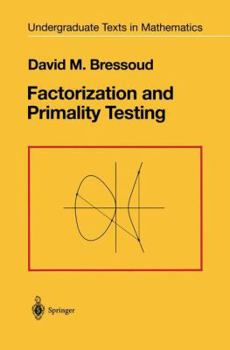Factorization and Primality Testing
Select Format
Select Condition 
Book Overview
About binomial theorems I'm teeming with a lot of news, With many cheerful facts about the square on the hypotenuse. - William S. Gilbert (The Pirates of Penzance, Act I) The question of divisibility is arguably the oldest problem in mathematics. Ancient peoples observed the cycles of nature: the day, the lunar month, and the year, and assumed that each divided evenly into the next. Civilizations as separate as the Egyptians of ten thousand years ago and the Central American Mayans adopted a month of thirty days and a year of twelve months. Even when the inaccuracy of a 360-day year became apparent, they preferred to retain it and add five intercalary days. The number 360 retains its psychological appeal today because it is divisible by many small integers. The technical term for such a number reflects this appeal. It is called a smooth number. At the other extreme are those integers with no smaller divisors other than 1, integers which might be called the indivisibles. The mystic qualities of numbers such as 7 and 13 derive in no small part from the fact that they are indivisibles. The ancient Greeks realized that every integer could be written uniquely as a product of indivisibles larger than 1, what we appropriately call prime numbers. To know the decomposition of an integer into a product of primes is to have a complete description of all of its divisors.
Format:Hardcover
Language:English
ISBN:0387970401
ISBN13:9780387970400
Release Date:October 1989
Publisher:Springer
Length:240 Pages
Weight:1.15 lbs.
Dimensions:0.8" x 6.4" x 9.5"
Customer Reviews
3 ratings
Old, but pertinent.
Published by Thriftbooks.com User , 15 years ago
As far as I can tell this is the first edition of a book written in 1989, almost 20 years ago. Fortunately, the material is still relevant. The author does a good job of presenting the information in a precise manner that is understandable to the reader. Still you will see that the largest Mersenne prime listed in the book is hopelessly out-of-date, and you will find some errors which were never corrected. May I request a second edition for this book as to make it up-to-date?
Excellent Text on Factorization
Published by Thriftbooks.com User , 24 years ago
This is one of the most compact and best organization of material on the subject of factorization and primality.Written by a promising author, this book explores factorization from the beginning to end, starting with the sieve of Eratosthenes and proceeding to much more complicated material. The book focuses on algorithms, and contains many useful ones, such as how to raise a number a to a power b, mod m. However, the primary focus of the book is factorization, so it contains algorithms for factorizations. They begin with trial division, then progress into Fermat's Algorithm and Pollard Rho. They eventually evolve into one of the strongest methods to date, Quadratic Sieve, and its child, Multiple Polynomial Quadratic Sieve.This book is certainly a must for amateurs who are exploring the subject.
Just the facts mam, just the facts.
Published by Thriftbooks.com User , 25 years ago
This book gives you the juicy bits you want for factoring and primality testing. It skips all the theory and presents the algorithims before you to observe and play with. For the amateur, this is an excellent first book.






